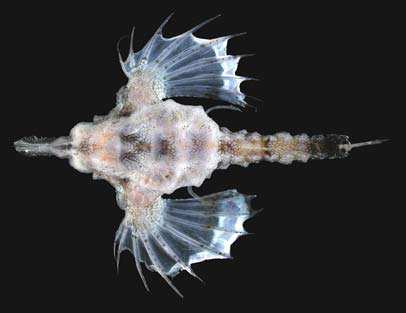| PEGASIDAE |


Eurypegasus draconis, 6.9 cm SL
(from Kagoshima Pref., Japan; photo by Hiroyuki Motomura)
|
Eurypegasus draconis (Linnaeus, 1766) Short Dragonfish |
|
D 5; A 5; P1 9-12. Pelvic-fin spine and first ray forming an elongate, tentacular structure. 3 pairs of dorsolateral body plates; 4 pairs of ventrolateral body plates; tail rings 8 (rarely 9), mobile. A pair of deep pits posterior to orbit; suborbital shelf concave, eye visible in ventral view; ventral ridges of rostrum greatly expanded than dorsal ridges, each with laterally directed denticles; anal papilla absent. Color: variable, body usually light to dark brown, with dark brown reticulations or mottled lines on dorsal and lateral surfaces; pectoral fins hyaline, distal margin white and spotted. Size: maximum length about 10 cm. Distribution: Indo-Pacific, from Red Sea and South Africa to Marquesan and Society Islands. Remarks: found on sand or silt bottoms to depths of at least 90 m. They are opportunistic feeders that collect mainly epifaunal and interstitial invertebrate prey, e.g., crustaceans and worms from the sediment-water interface. |
|
|